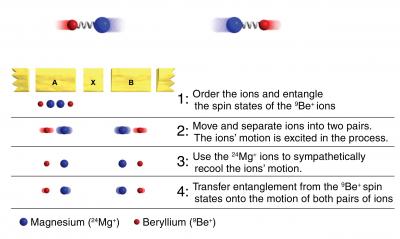Physicists at the National Institute of Standards and Technology (NIST) have demonstrated entanglement—a phenomenon peculiar to the atomic-scale quantum world—in a mechanical system similar to those in the macroscopic everyday world. The work extends the boundaries of the arena where quantum behavior can be observed and shows how laboratory technology might be scaled up to build a functional quantum computer.
The research involves a bizarre intertwining between two pairs of vibrating ions (charged atoms) such that the pairs vibrate in unison, even when separated in space. Each pair of ions behaves like two balls connected by a spring , vibrating back and forth in opposite directions. Familiar objects that vibrate this way include pendulums and violin strings.
Nothing makes modern progressives happy like hoping mankind regresses and nothing makes modern conservatives happy like hoping progress in the future will clean up the environment.
Both sides may win, according to research led by Durham University. The secret of a successful sandcastle could aid the revival of an ancient eco-friendly building technique in the future. Parts of the Great Wall of China and the Alhambra at Granada in Spain were built using 'rammed earth', which means it lasts a long time and is sustainable, pleasing one side, and both of those have military applications, pleasing the other.
Sleeping pills have been associated with a four-fold increase in suicide risk in the elderly but is it just bad correlation, in that sleeping pills are just a convenient way to commit suicide? Researchers writing in the BMC Geriatrics say that after adjusting for the presence of psychiatric conditions sedatives and hypnotics were both associated with an increased risk of suicide.
Anders Carlsten and Margda Waern from Gothenburg University carried out a case control study to determine whether specific types of psychoactive drugs were associated with suicide risk in later life.
A national Radiation Therapy Oncology Group (RTOG) study led by a Medical College of Wisconsin Cancer Center physician at Froedtert Hospital in Milwaukee has found that a course of radiation therapy to the brain after treatment for locally advanced non-small cell lung cancer reduced the risk of metastases to the brain within the first year after treatment. The study was presented at the American Society of Clinical Oncology annual meeting in Orlando.
Like human infants, young apes are make noises when you tickle them. Is that really laughter? The answer to the question is yes, say researchers in Current Biology.
The researchers analyzed the recorded sounds of tickle-induced vocalizations produced by infant and juvenile orangutans, chimpanzees, gorillas, and bonobos, as well as those of human infants. A quantitative phylogenetic analysis of those acoustic data found that the best "tree" to represent the evolutionary relationships among those sounds matched the known evolutionary relationships among the five species based on genetics. The researchers said that the findings support a common evolutionary origin for the human and ape tickle-induced expressions.
Electronic memory chips may soon gain the ability to bend and twist, thanks to engineers at the National Institute of Standards and Technology (NIST)(1). Not too exciting, right? You probably don't spend a lot of time bending memory chips now but electronic components that can flex without breaking are coveted by portable device manufacturers for less Stretch Armstrong-type reasons; people have a tendency to drop their mp3 players and they could lead to small medical sensors that can be worn on the skin to monitor vital signs such as heart rate or blood sugar, benefitting patients with conditions that require constant maintenance.
Though some flexible components exist, creating flexible memory has been a technical barrier, according to NIST researchers.
 Opioid Addicts Are Less Likely To Use Legal Opioids At The End Of Their Lives
Opioid Addicts Are Less Likely To Use Legal Opioids At The End Of Their Lives More Like Lizards: Claim That T. Rex Was As Smart As Monkeys Refuted
More Like Lizards: Claim That T. Rex Was As Smart As Monkeys Refuted Study: Caloric Restriction In Humans And Aging
Study: Caloric Restriction In Humans And Aging Science Podcast Or Perish?
Science Podcast Or Perish?









